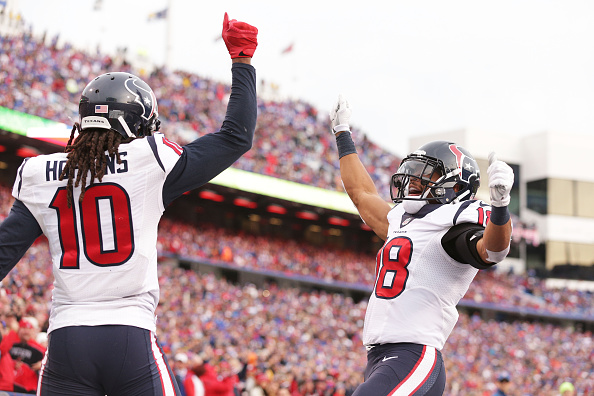Houston Hangover?
Texans Respond to Playoff Disappointment with Offensive Overhaul
With a season ending in ultimate disappointment for the Texans, (See: last year’s Wild Card Round) still, a lot of great things occurred. They finished up the regular season as division champs, winners of seven of their last nine, featuring five wins in which the opposition failed to score over six points. Their defense got white hot down the stretch, ultimately finishing third in total defense and seventh in scoring defense. Simply put, there was a moment during the 2015 season when nobody wanted to play Houston. This is a testament to their front office acumen, personnel selection, and confident and competent coaching staff. A team predicated on defense – as we saw last season with the Broncos – is capable of winning a championship, but a team so deficient offensively is incapable of making any noise in the playoffs – as we saw with these very Texans in 2015. Considering this, the Texans brass made it a point to overhaul their entire offense, beginning in free agency and ending in the NFL Draft.
Quarterback
In today’s game, the offense – and some may argue to a further extent – the entire team is predicated on quarterback play. In the simplest of terms, Houston was incapable of showing up on Wild Card weekend last season because of their lack of a presence at the position. Brian Hoyer – although he posted a 5-4 record as a starter – was not the answer that Houston needed in 2015. In 11 contests, he threw for a mere 2,606 yards, while his 60.7 completion percentage was less than stellar. Recognizing this, decision makers in Houston set out to upgrade at quarterback during the offseason.

Brock Osweiler – fourth year quarterback out of Arizona State – is certainly a player shrouded in unknowns. However, with Denver last season, he won five of his seven starts and showed flashes of special ability. He’s built into a massive 6-foot-8, 240 lbs. frame, and did a solid job standing strong in a pocket that was largely non-exsistent from the Broncos' abysmal offensive line last season.

After inking a four-year, $72 million contract this past March, Osweiler comes into Houston with still plenty to prove. $37 million in guaranteed money tends to put a lot of pressure on a quarterback. Luckily, as the rest of this feature will fill you in on, the Texans committed to building around young Mr. Osweiler. With a fresh start, a stud receiver in DeAndre Hopkins, and largely young and talented surrounding cast around him, Osweiler has no excuse to fail in Houston.
Running Back
For the better part of the last decade, the Texans running game has begun and ended with Arian Foster – a former All-Pro and four-time Pro Bowl running back. Unfortunately, the complete back’s only flaw happened to be his health; an issue that became so bad in recent years that the Texans were forced to give up on him during this offseason. Again, in hopes of making a legitimate playoff run in 2016, the Texans took a perceived weakness and turned it into a surefire strength with an addition in free agency.
In early March, Lamar Miller – formerly of the Miami Dolphins – and the Texans agreed to a four-year, $26 million deal. A reasonable contract with little risk for Houston, while his skillset and rate of production is largely underrated amongst league-wide pundits. Early on in this offseason, I had Miller ranked as the top free agent running back and explained it as such:
“While a bit crowded at the top in this deep class of free agent running backs, Miller enters the offseason as the No. 1-rated runner on my board. On top of being only 25 years of age when the season starts in September, Miller has received a very light workload for a starting running back over his first four years in the league, with his high mark coming in at a mere 216 rush attempts in 2014. Out of all of the elite free agent backs listed, Miller by far has the freshest legs, giving him the edge on this list over Doug Martin and Matt Forte by a relatively comfortable margin.
Simply put, the signing is a home run for Houston. They get a multi-faceted back, who can run between the tackles, on the edge, and can catch the ball out of the backfield. He’s one of the smoothest runners in the league, and his vision is up there with the best of them.
/cdn0.vox-cdn.com/uploads/chorus_asset/file/5044203/lamar.0.gif)
Sure, he may not be the best short-yardage guy in the league, but with all of the other things that he does so well, there is no reason to think that Miller will not finish as a top-10 running back in most fantasy formats this upcoming season.
Receivers
While already considered a true No. 1 target based off his play in years past, DeAndre Hopkins broke out in 2015 with a staggering 111 catches, 1,521 receiving yards, and 11 touchdowns. Most impressive of all is that he managed to compile these big-time numbers while the Texans struggled to trot out anything better than Uncle Rico level quarterback play.

The fact that Osweiler was brought in to upgrade at the position should alone give Hopkins a boost in production. However, the Texans took it a step further this offseason by giving him some talented teammates on the outside to work with.
With two of their top three draft picks, Houston selected not one, but two, wide receivers included in my pre-draft top receiver rankings. In hopes of perfectly complimenting DeAndre Hopkins’ game of precision route-running and “go up and get it” playmaking ability, the Texans took two of the draft’s fastest and most naturally athletic receivers.
First, in Will Fuller of Notre Dame, the Texans got the fastest player in the draft (4.32 40-time). He displayed on tape some of the most explosive playmaking ability out of any draft eligible player. He’ll come into Houston, working as a flanker opposite Hopkins, likely running ample fly routes and deep posts, in hopes of taking on the attention of the defense and ultimately double teams away from Hopkins. Here’s an example of his elite speed. He absolutely smokes USC’s Adoree’ Jackson – one of college football’s best cornerbacks.
As for the Texans' third-round choice, Braxton Miller comes in as a bit of a project, but he is a player with abundant talent. A former dual-threat quarterback at Ohio State, Miller twice finished as the Big 10’s conference player of the year. He also finished in the top 10 for Heisman voting in 2013 in just his sophomore season. With a logjam at the position last season, Miller swallowed his pride and switched positions in hopes of improving his draft stock and most importantly helping his team. He did not disappoint, as he proved to be Ohio State’s most dynamic offensive weapon not named Ezekiel Elliot – a role that he would similarly like to fill for the Texans in 2016 and beyond. In the slot alongside DeAndre Hopkins and across from Fuller, Miller will be able to provide Osweiler with an excellent short-ranged option to gain easy yards. He’s a dynamic playmaker with the ball in his hands, and will likely get served designed gadget runs and swing screen outlets. Here’s an example of the explosive moves Miller has in the open field.
Offensive Line
Featuring a mediocre running game and a disappointing passing attack, it goes without saying that the 2015 Texans could have used some help along the offensive line. With their second round draft selection in the 2016 NFL Draft this April, Houston chose another Notre Dame product – Nick Martin a versatile interior offensive lineman.
Martin – brother of All-Pro Dallas Cowboys right guard Zack – is also athletically gifted and can play multiple positions along the offensive line. While he doesn’t possess the natural strength of his brother Zack, Nick Martin utilizes precision technique and adequate quickness to get an edge on second level defenders.
While I had the Texans mocked to select Alabama’s center Ryan Kelly a few times throughout the pre-draft process, they missed the opportunity by just a few picks and instead ended up with Notre Dame’s Will Fuller. Although they were unable to take the best center in the draft in the first round, they wisely used their second round pick on the second-best center in the draft – Martin – who while versatile along the offensive line, is likely best suited as a center in the pros. He will enter the season as a starter somewhere on the interior offensive line, with center being his most likely landing spot.
Conclusion
With all of these additions, the Texans took a page out of the Broncos' Super Bowl-winning formula. When Denver’s offense set all of those records a couple of seasons ago, they set out in the offseason and spent tons of money and draft picks on bringing their defense up to speed. In this situation, the Texans viewed their defense as one of the league’s best, while their offense was holding them back. With tremendous investment in their offense this offseason, the Texans and their loyal fan base are hoping that they can find similar success to that of the 2015 Broncos sooner rather than later. Fantasy owners should take this as a public service announcement. Owning a Texans player outside of Hopkins is no longer a sign that your team is going down in flames. Owning a Texans player now might just give you one of the best sleeper picks of the season.

